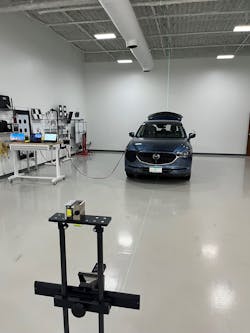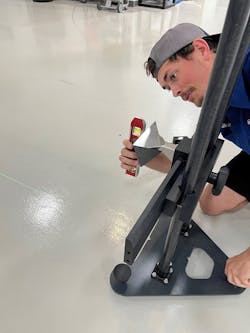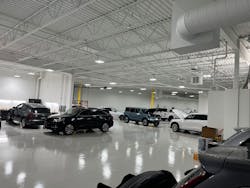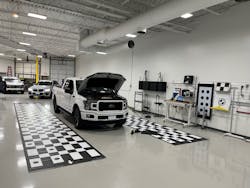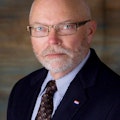I have written in the past about the need to perform scans and calibrations as specified by vehicle manufacturers while performing collision and other repairs. The topic has been widely discussed and covered by our trade press for a number of years now. But based on data from CCC, the industry has been exceedingly slow to universally embrace it. That data found that only about 50 percent of estimates contain the term “scan,” and fewer than 15 percent contain the term “calibrate.” It’s a safe assumption that the percentage of repaired vehicles requiring such work, based on vehicle manufacturer procedures and guidelines, is far greater. As a repairer, if you haven’t embraced this yet, please do so immediately, if nothing else for the sake of safety for the rest of us on the roadways we share.
This article is for those who appreciate the need for advanced driver assistance systems (ADAS) maintenance and repair. We should be doing this work first and foremost for the safety of our customers as well as the overall motoring public. It’s simply the right thing to do. Secondly, there are advantages for your business, even if you sublet the work and get some sort of markup or administrative fee. Using the various sources of third parties can also provide some income opportunities. And for those with resources who are venturesome enough to get into the business, there are growing opportunities that can complement your collision business and perhaps even become a stand-alone business. Many experts predict the ADAS repair and maintenance industry will grow into significance in the future, reaching somewhere in the tens of billions of dollars in the U.S. per year.
A brief history of ADAS calibrations
It’s only been about eight to 10 years since our collision industry started to awaken to the need for scans. Sounding the alarm were speakers such as Mike Anderson, who interacted with vehicle manufacturers and studied their repair procedures. While the service/mechanical industry has been dealing with scan tools, control modules, programming, and more for a few decades, the advent of ADAS was and still is a new twist. The increased use of vehicle manufacturer repair procedures led to more scans, then to more diagnostics, and finally to ADAS calibrations. Thanks to the rapidly growing complement of ADAS features on the newest vehicles the collision industry was thrust into it, though in too many cases with hesitance or reluctance. Training entities, such as I-CAR, started research and have since developed many very good training opportunities.
Since then, a number of new calibration businesses have appeared, including some franchise models.
Over the course of 11 years, LaMettry’s Collision — where I work, in Minneapolis/St. Paul — developed a mechanical side to the business, and with that started a business called Accelerated Vehicle Technology. Included is a growing calibration center we started about four years ago. We’ve been learning so very much as we go. Mostly, it started with a talented, energetic, and conscientious staff who did immense research, including through manufacturer repair procedures. To this day, this isn’t the type of business, like collision, where you can get performance benchmarks, management systems, advice from peers and experts, or other guidance. It is not as easy as it may appear. It is very expensive to set up and maintain, especially if one wishes to service virtually all brands and models. It is complicated. Establishing flow and communication operating procedures and tools can be as difficult as mastering new vehicle technologies. Establishing pricing structures that provide profit potential with minimal friction and complication with customers, especially insurers, is a challenge.
I will share some of what we have learned.
ADAS demands capable diagnosticians
No different than any other entity, having the right people is the key to success. I highly recommend starting with people of the highest level of competence and personal attributes. They should be motivated and hungry to learn, and in fact fascinated with the latest innovations. They must be willing and able to train others. Expect such candidates to be expensive, but these people are the cornerstone of building the new business and its culture.
One beauty of ADAS work is that there are possibilities for people of origins different than what we are accustomed to in collision repair. I’ve seen experienced body techs and mechanical techs transition into this. People with great computer skills, including those who service computerized systems, can be candidates. It can be easier to train “techy” people on autos than the other way around. Mechanical and electrical engineers can be good candidates. Even though their expected pay rates can be higher than many collision jobs, this industry will demand higher caliber skills. Traditional mechanical diagnosticians can be candidates. Since many calibrations fail, due to many reasons, having people with the ability to diagnose complex electrical situations is a necessity. Though this is all very new, I’ve already seen examples of tech school students embracing ADAS work as a vocation.
The higher skilled and more experienced ADAS techs will command a high level of compensation. I would equate their skill level to that of the better diagnosticians at a dealership and pay them accordingly. Of course, entry-level techs will command a lower level of compensation, though periodic performance reviews and pay rate increases will be needed as they perfect their skills and productivity. I personally prefer paying ADAS technicians a salary rather than a flat rate or incentive plan. We want to emphasize quality and safety over productivity. In this model it is up to management to ensure that techs take ownership of productivity and efficiency by creating the appropriate messaging, ideally leading to a culture of accountability.
Facility requirements
There are a number of entities such as collision shops, mechanical shops, dealerships, etc. who are attempting some ADAS work in their existing facilities. As time goes on, I predict more and more will realize the importance of a flat floor, controlled lighting, ample space, minimal light and movement distractions, bland walls without windows, bland ceilings without skylights, powerful Wi-Fi capabilities, cleanliness, parking lots that accommodate tow trucks, storage areas for targets and sensitive electronic equipment, good security, and areas for training. Since most of the work is internal or business-to-business, a location with great visibility isn’t necessary, though being conveniently located to internal and retail customers is preferrable. It is necessary to have sufficient room to park waiting and completed vehicles, along with space for flatbed trucks to pick up and deliver.
Develop a process
I believe that, especially when interacting with multiple collision shops, mastering the process is as challenging as mastering the ADAS technology. If you think in terms of the flow of the vehicle, the people who first interact with the customer need to have some ADAS knowledge to prepare the customer for the various aspects and requirements of the repair. Collision repair on vehicles with ADAS takes longer and has more steps. These staff members should inform the customer of the safety aspects. It’s considered a good practice to discuss the customer’s knowledge of ADAS and what systems have been turned off. And to protect all, it is best practice to activate all systems after the repair, similar to how a dealer would prep a new vehicle for delivery. The shop estimator, or blueprinter, who prepares the blueprint — hopefully after a complete teardown — must reference vehicle manufacturer repair information and should incorporate ADAS scans and calibrations on the initial estimate/blueprint.
Unless the estimator is exceptionally well versed in ADAS, it may be helpful to use a third-party resource to identify ADAS features and required calibrations. There are some apps available, and more are coming. A good alternative is to have an ADAS technician inspect the vehicle, help look up manufacturer procedures, and identify ADAS needs. The estimator needs to be familiar enough to explain the required work to the customer and to the insurer, provide supporting documentation, and discuss/negotiate with the insurer.
The body and paint techs must have some understanding of ADAS to take appropriate precautions. Discussions with the production manager and ADAS technicians must take place in regard to components that may need to be left off before calibration, such as a bumper cover, to accommodate a blind spot monitor calibration.
And finally, the appropriate calibrations, and perhaps vehicle transport, must be scheduled with ADAS techs. And last but not least, a process to handle billing is required. Everyone in the process must be trained and prepared to handle all the appropriate steps with the best possible proficiency and accuracy. Because of the many variables in collision repair, communication and scheduling can be complicated.
We have found there are typically many — more than 20 percent — of calibrations that fail for a wide array of reasons. The ADAS shop’s responsibility is to communicate with the collision shop to accommodate appropriate time and interaction to diagnose the cause of the issue then complete a successful calibration. Additional time required may have to be discussed with customers and/or insurers. Loose connections, pinched or cut wires, tweaked sensor mounting brackets, failed sensors, and failed modules are among the many possible causes.
All of these steps must be taken into consideration when establishing processes and standard operating procedures (SOPs).
Equipment considerations
When people start considering getting into the ADAS business, often their first thoughts go to equipment. I have conducted many tours of our calibration center, and the most common question is, “What calibration station and equipment should I buy?” Before answering, I would say that the competence of the staff is more important than the brand name on the equipment. (Assuming the consideration is only high-quality/industrial-use equipment. Competent people will soon figure out good equipment solutions.) Expect the cost of purchasing and maintaining ADAS equipment to be high and ongoing. I believe it’s wise to look at all major brands and have an array. At our calibration center we have five calibration stations from four different brands. Each has its pros and cons. Each brand is working hard on development, and the scene is evolving. What you think is the best solution today may not be the best in a few months.
There are many high-quality aftermarket scan tools that can work well on most vehicle brands for most tasks. These tools are often the most cost-effective and efficient. But knowing their limitations is the key. At our calibration center, we’ve evolved to acquiring and using more and more factory scan tools. In most cases, these are factory programs loaded on a high-quality durable laptop. We’ve found that many of these programs are incompatible with other manufacturers’ programs as well as laptop security systems. Therefore, we now have a wide array of laptops, each dedicated to a specific vehicle brand. And of course, each comes with subscription costs and the need for updates.
The calibration center will need to be equipped with a variety of electrical diagnostic tools, hand tools, measurement tools (we like lasers), battery support tools, carts, benches, etc. Having flat floors means no slope for drainage, so cleaning the shop takes on new aspects. Mops, buckets, and squeegees work, but an automated floor scrubber is nicer.
A shop management system will be required for billing and reporting and scheduling. There are a number of systems designed for independent mechanical shops that work fine for an ADAS business. If your ADAS business is part of or associated with a collision repair business, it can be very helpful to have access to the collision management system. Among the many advantages are the ability to better understand the nature of the vehicle damage, insurance involvement, posting invoices, creating supplements, adding additional photos, and more.
How to approach pricing
The business of ADAS is new, and therefore typical pricing models, such as in traditional independent mechanical shops or collision shops, are not common. One can research the few independent ADAS businesses to learn how they price their services. Dealers can also be sourced, though their pricing may not be as structured if they don’t do many calibrations.
For reasons of anti-trust regulation, I will not suggest specific numbers. However, I will provide a few pointers based on my experience.
Especially when interacting with insurers, I prefer a pricing model based on dollars rather than labor time. Using labor times can lead to discussions on how long the task took. Actual time required for calibrations can vary a lot, even within the same brands and models. Dynamic calibrations are affected by road and weather conditions. Some scan tools and calibration centers are faster or slower than others. There are also variables in static calibration. And discussions on how long a task took can become a friction point in an insurance relationship. I also believe that pricing ADAS work is different than pricing other auto repair work. The cost of purchasing and maintaining equipment is so expensive that the pricing model must take that into account for a successful business model.
I have found that more simplistic pricing models serve us well. Some ADAS businesses have complicated models with different pricing depending upon the unit being calibrated and whether it is a dynamic or static calibration. It makes sense in terms of attempting to be precise in terms of the labor cost of each operation. But again, this leads to more questions and possible confusion and friction. And it makes it difficult to address equipment and software costs. Ideally, most calibrations are set at one price based on dollars. It’s easy for all staff to remember, explain, and implement.
Scan pricing should be looked at similarly. If the pricing is set at a dollar amount that amply covers labor and equipment and software and some variables it works well. I like a model that includes researching diagnostic trouble codes, battery support, warming the vehicle, minor initializations, and clearing codes after they are all addressed. Most definitions of scans, including those from information providers, include only connecting the scan tool and capturing codes and nothing more. Thus, some insurers push for a lesser price for the operation. In those cases, we consider all the non-included operations and add à la carte pricing accordingly. This complicates and may add friction points, but if the insurer doesn’t want to consider all the steps and demands a lesser price, one has little choice.
I suggest that when pricing, one takes into consideration that it may become preferable, on rare occasions, to perform the operation at no charge. I know from experience; you may get into situations where an insurer or customer simply refuses to pay for a required scan. It is better to do what is right and best for the vehicle and customer than to deliver a potentially unsafe vehicle because someone won’t cover a charge. Having some modest profit built into the charges to accommodate such situations simply makes sense, especially understanding our industry can be slow to react to new technologies and may not get it right. Cost-shifting is typically not advisable. But in the big picture, it doesn’t happen often and thus isn’t a lot of money overall. I consider this a situation where it is best to prioritize doing what is right and best in terms of safety and function. In other words, be profitable enough that the business can afford to do an occasional scan at no charge. The same can apply to calibration and other operations.
Realistic expectations for profitability
Since this is such a new segment of the auto repair industry, there is very little data on typical benchmarks such as gross profit, net profit, labor gross profit, cycle times, productivity per tech, etc. I am not aware of any ADAS-calibration 20 groups. In my experience, we’ve simply been finding our own way, utilizing what we know from other auto repair segments, and analyzing results.
My impressions are that the ADAS industry segment isn’t going to create wealth like some high-profile industries. I wouldn’t expect net profits of 25 to 50 percent, and I don’t see Bill Gates or Warren Buffet scrambling to get into this. In fact, I would suggest that net profits of 15 to 25 percent would be a lofty goal and highly unlikely while acquiring equipment and software. I believe a well-run ADAS business can produce profits of 5 to 15 percent. But having a new startup business considered “well-run” can be a challenge. I strongly advise that the startup owner/operator pay close attention and expect to be very engaged to be successful. I would not be optimistic about a model where one sets up a manager with limited experience, provides some equipment, training, and an incentive pay plan, then steps away.
The ADAS business outlook
I think it is clear to most of us that the ADAS maintenance/repair industry is growing rapidly and presents huge opportunities. Some predict that the industry will grow to tens of billions of dollars per year in the not-so-distant future. For the collision repairer willing to invest and take the risks, there is an opportunity to fill potential shortages of collision repair work, presumably declining due to improving safety systems. (Though in our current very busy marketplace, it is hard to see that happening soon.) And at the same time, I offer some words of caution based on experience. Providing ADAS repair, especially on all or most vehicle brands, is very complicated and expensive. Complicated technologies require extensive diagnostic skills well beyond performing calibrations. There are ongoing requirements of constantly updating equipment and software, huge challenges in hiring and training staff, and increasing competition. Some businesses will fail, as typically happens in new industry segments. If you are so inclined to jump in, do your research and develop a plan and a budget.
About the Author
Darrell Amberson
Vice president of industry and OEM relations
Darrell Amberson is the vice president of industry and OEM relations at Quality Collision Group.
Previously, he was president of operations for LaMettry's Collision, a 10-location multi-shop operator in the Minneapolis area purchased by Quality Collision Group in November 2024. Amberson has more than 40 years of collision industry experience and served as chairman of the Collision Industry Conference for the 2021-2022 term, as well as interim chairman for the first two CIC meetings of 2024.

